Case Study Analysis: Working Capital and Budgeting for Two Companies
VerifiedAdded on 2022/08/22
|17
|3726
|28
Case Study
AI Summary
This case study analyzes the financial management of Mediterranean Delights Ltd (MDL) and Second Sight Plc. The first part focuses on MDL's working capital, cash flow, and profit, highlighting the impact of debts, inventory, and receivables on its financial health. Recommendations include improving cash flow through effective working capital management, such as slowing accounts payable, collecting receivables promptly, and efficient inventory management. The second part examines Second Sight Plc's budgeting systems, comparing traditional, rolling, zero-based, and activity-based budgeting. The analysis concludes that activity-based budgeting is the most effective, despite its cost, and should be implemented for effective budgeting for their new project. The study emphasizes the importance of financial planning, debt management, and choosing appropriate budgeting methods for organizational success.
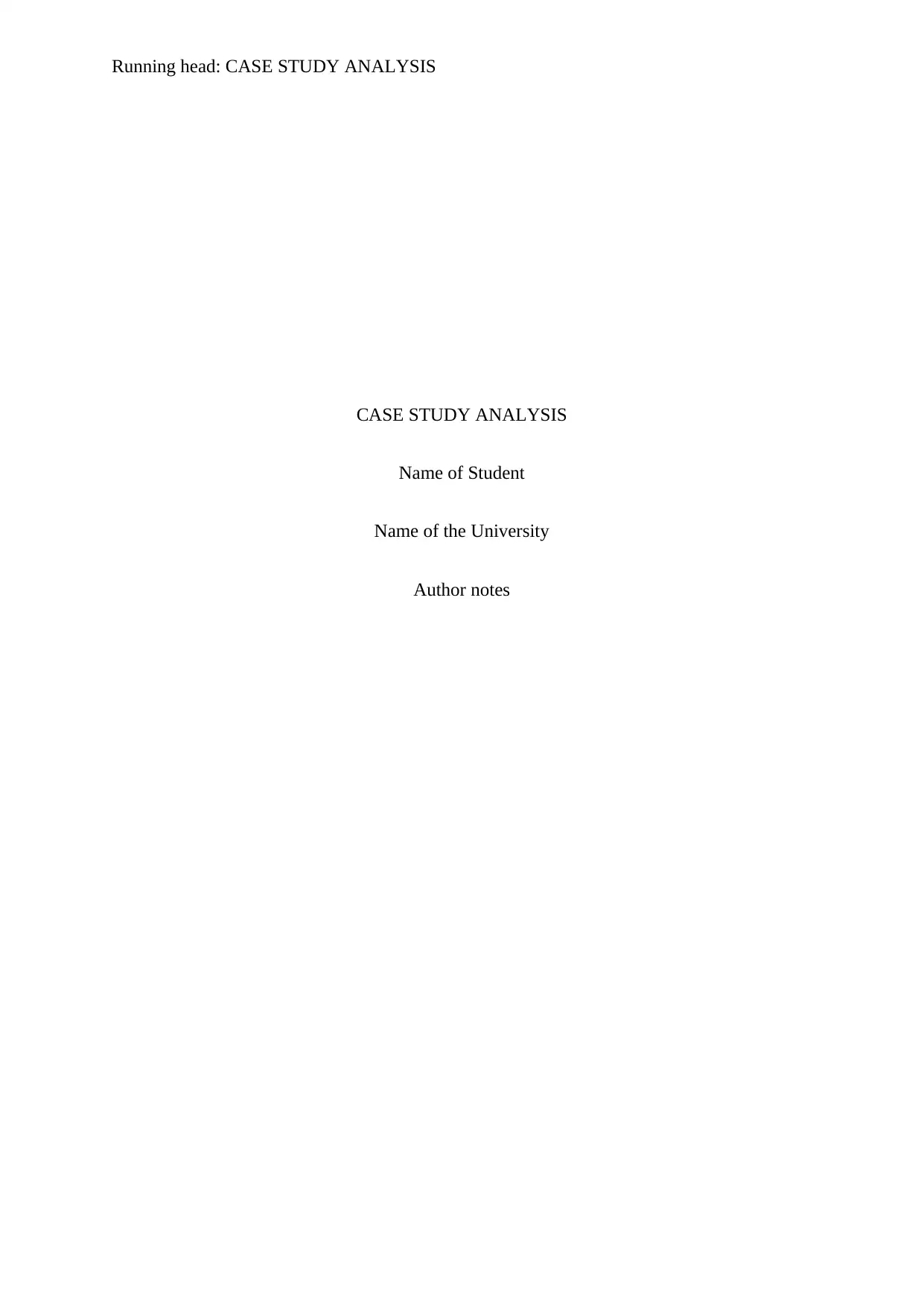
Running head: CASE STUDY ANALYSIS
CASE STUDY ANALYSIS
Name of Student
Name of the University
Author notes
CASE STUDY ANALYSIS
Name of Student
Name of the University
Author notes
Paraphrase This Document
Need a fresh take? Get an instant paraphrase of this document with our AI Paraphraser
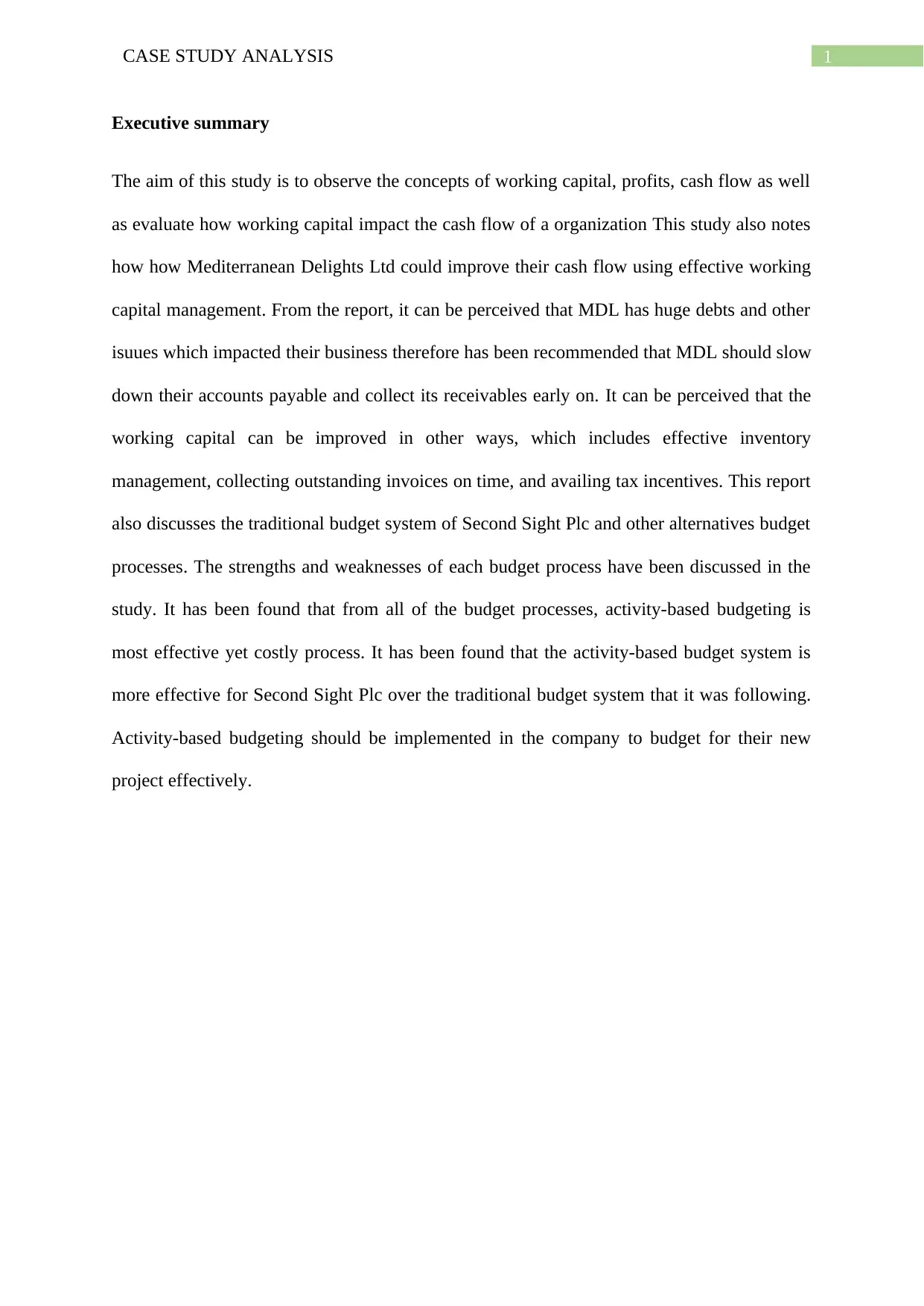
1CASE STUDY ANALYSIS
Executive summary
The aim of this study is to observe the concepts of working capital, profits, cash flow as well
as evaluate how working capital impact the cash flow of a organization This study also notes
how how Mediterranean Delights Ltd could improve their cash flow using effective working
capital management. From the report, it can be perceived that MDL has huge debts and other
isuues which impacted their business therefore has been recommended that MDL should slow
down their accounts payable and collect its receivables early on. It can be perceived that the
working capital can be improved in other ways, which includes effective inventory
management, collecting outstanding invoices on time, and availing tax incentives. This report
also discusses the traditional budget system of Second Sight Plc and other alternatives budget
processes. The strengths and weaknesses of each budget process have been discussed in the
study. It has been found that from all of the budget processes, activity-based budgeting is
most effective yet costly process. It has been found that the activity-based budget system is
more effective for Second Sight Plc over the traditional budget system that it was following.
Activity-based budgeting should be implemented in the company to budget for their new
project effectively.
Executive summary
The aim of this study is to observe the concepts of working capital, profits, cash flow as well
as evaluate how working capital impact the cash flow of a organization This study also notes
how how Mediterranean Delights Ltd could improve their cash flow using effective working
capital management. From the report, it can be perceived that MDL has huge debts and other
isuues which impacted their business therefore has been recommended that MDL should slow
down their accounts payable and collect its receivables early on. It can be perceived that the
working capital can be improved in other ways, which includes effective inventory
management, collecting outstanding invoices on time, and availing tax incentives. This report
also discusses the traditional budget system of Second Sight Plc and other alternatives budget
processes. The strengths and weaknesses of each budget process have been discussed in the
study. It has been found that from all of the budget processes, activity-based budgeting is
most effective yet costly process. It has been found that the activity-based budget system is
more effective for Second Sight Plc over the traditional budget system that it was following.
Activity-based budgeting should be implemented in the company to budget for their new
project effectively.
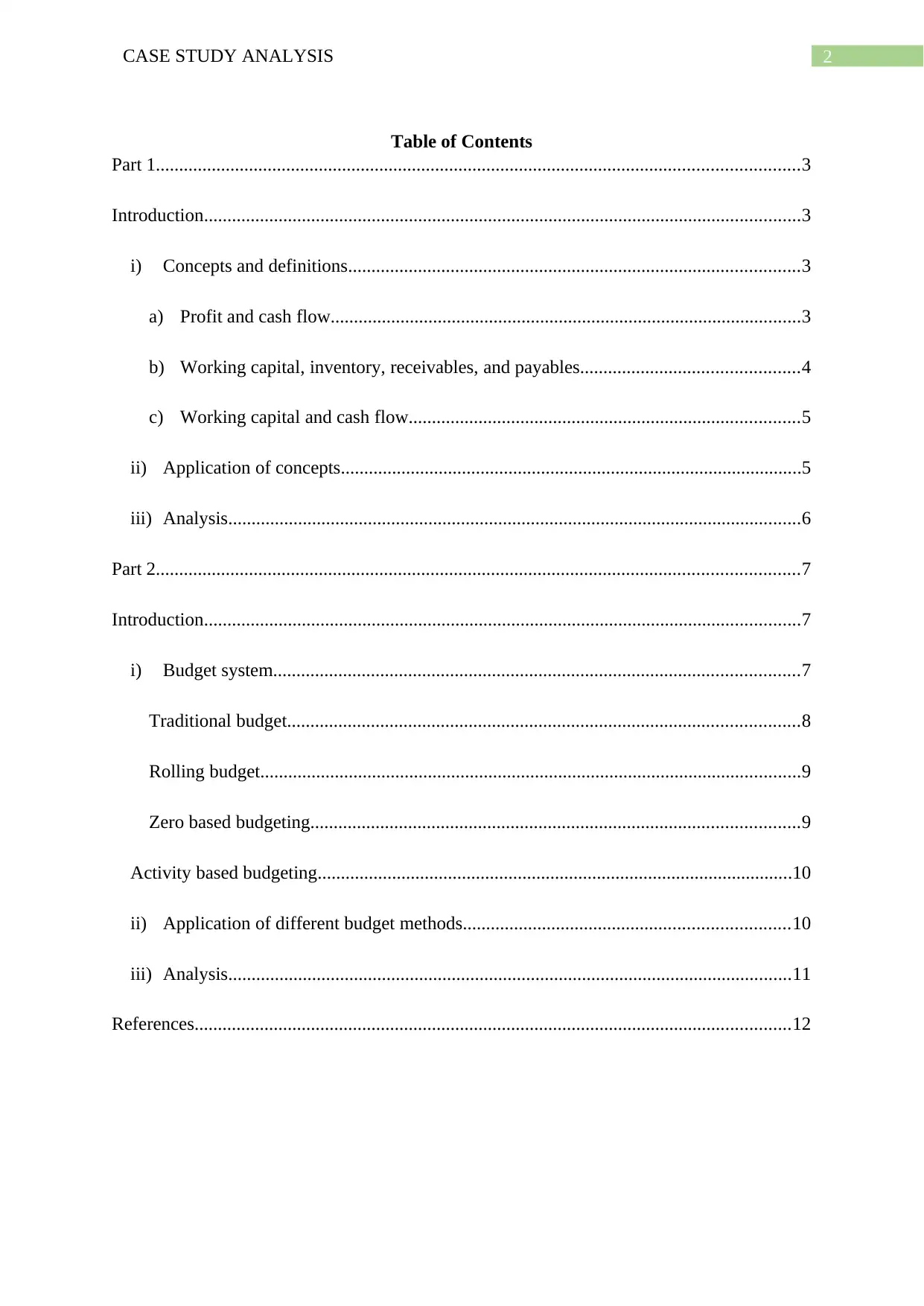
2CASE STUDY ANALYSIS
Table of Contents
Part 1..........................................................................................................................................3
Introduction................................................................................................................................3
i) Concepts and definitions.................................................................................................3
a) Profit and cash flow.....................................................................................................3
b) Working capital, inventory, receivables, and payables...............................................4
c) Working capital and cash flow....................................................................................5
ii) Application of concepts...................................................................................................5
iii) Analysis...........................................................................................................................6
Part 2..........................................................................................................................................7
Introduction................................................................................................................................7
i) Budget system.................................................................................................................7
Traditional budget..............................................................................................................8
Rolling budget....................................................................................................................9
Zero based budgeting.........................................................................................................9
Activity based budgeting......................................................................................................10
ii) Application of different budget methods......................................................................10
iii) Analysis.........................................................................................................................11
References................................................................................................................................12
Table of Contents
Part 1..........................................................................................................................................3
Introduction................................................................................................................................3
i) Concepts and definitions.................................................................................................3
a) Profit and cash flow.....................................................................................................3
b) Working capital, inventory, receivables, and payables...............................................4
c) Working capital and cash flow....................................................................................5
ii) Application of concepts...................................................................................................5
iii) Analysis...........................................................................................................................6
Part 2..........................................................................................................................................7
Introduction................................................................................................................................7
i) Budget system.................................................................................................................7
Traditional budget..............................................................................................................8
Rolling budget....................................................................................................................9
Zero based budgeting.........................................................................................................9
Activity based budgeting......................................................................................................10
ii) Application of different budget methods......................................................................10
iii) Analysis.........................................................................................................................11
References................................................................................................................................12
⊘ This is a preview!⊘
Do you want full access?
Subscribe today to unlock all pages.

Trusted by 1+ million students worldwide
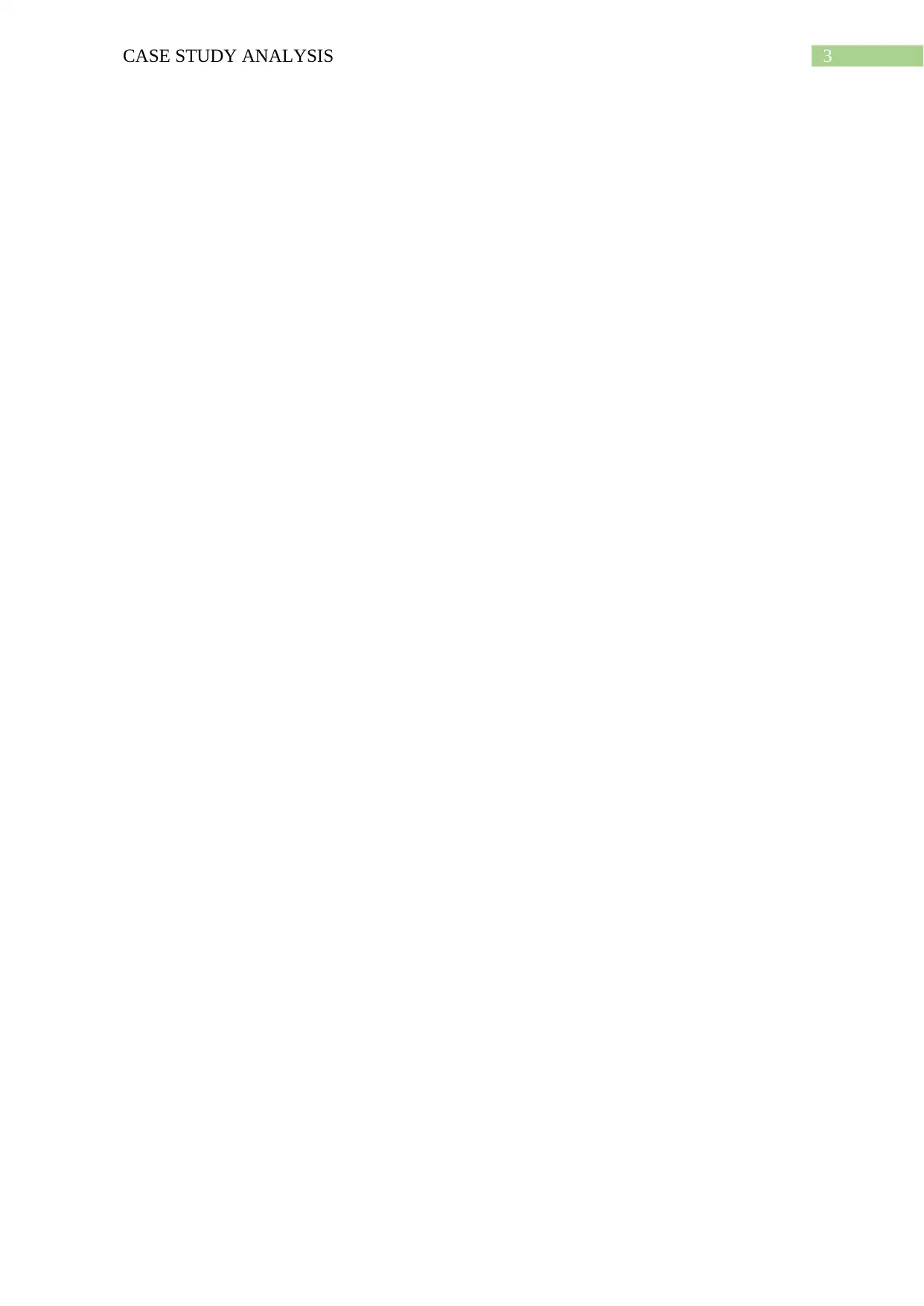
3CASE STUDY ANALYSIS
Paraphrase This Document
Need a fresh take? Get an instant paraphrase of this document with our AI Paraphraser
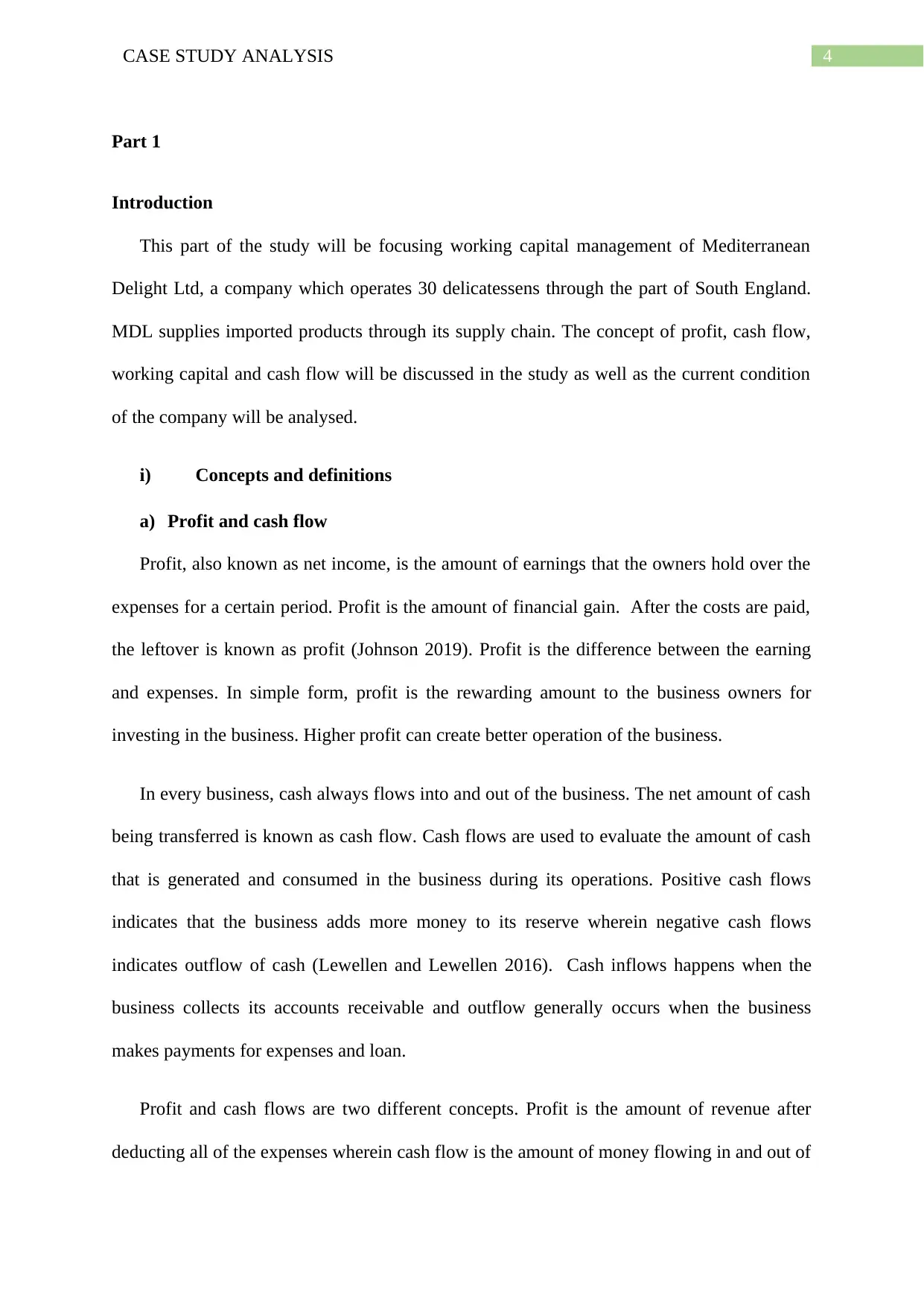
4CASE STUDY ANALYSIS
Part 1
Introduction
This part of the study will be focusing working capital management of Mediterranean
Delight Ltd, a company which operates 30 delicatessens through the part of South England.
MDL supplies imported products through its supply chain. The concept of profit, cash flow,
working capital and cash flow will be discussed in the study as well as the current condition
of the company will be analysed.
i) Concepts and definitions
a) Profit and cash flow
Profit, also known as net income, is the amount of earnings that the owners hold over the
expenses for a certain period. Profit is the amount of financial gain. After the costs are paid,
the leftover is known as profit (Johnson 2019). Profit is the difference between the earning
and expenses. In simple form, profit is the rewarding amount to the business owners for
investing in the business. Higher profit can create better operation of the business.
In every business, cash always flows into and out of the business. The net amount of cash
being transferred is known as cash flow. Cash flows are used to evaluate the amount of cash
that is generated and consumed in the business during its operations. Positive cash flows
indicates that the business adds more money to its reserve wherein negative cash flows
indicates outflow of cash (Lewellen and Lewellen 2016). Cash inflows happens when the
business collects its accounts receivable and outflow generally occurs when the business
makes payments for expenses and loan.
Profit and cash flows are two different concepts. Profit is the amount of revenue after
deducting all of the expenses wherein cash flow is the amount of money flowing in and out of
Part 1
Introduction
This part of the study will be focusing working capital management of Mediterranean
Delight Ltd, a company which operates 30 delicatessens through the part of South England.
MDL supplies imported products through its supply chain. The concept of profit, cash flow,
working capital and cash flow will be discussed in the study as well as the current condition
of the company will be analysed.
i) Concepts and definitions
a) Profit and cash flow
Profit, also known as net income, is the amount of earnings that the owners hold over the
expenses for a certain period. Profit is the amount of financial gain. After the costs are paid,
the leftover is known as profit (Johnson 2019). Profit is the difference between the earning
and expenses. In simple form, profit is the rewarding amount to the business owners for
investing in the business. Higher profit can create better operation of the business.
In every business, cash always flows into and out of the business. The net amount of cash
being transferred is known as cash flow. Cash flows are used to evaluate the amount of cash
that is generated and consumed in the business during its operations. Positive cash flows
indicates that the business adds more money to its reserve wherein negative cash flows
indicates outflow of cash (Lewellen and Lewellen 2016). Cash inflows happens when the
business collects its accounts receivable and outflow generally occurs when the business
makes payments for expenses and loan.
Profit and cash flows are two different concepts. Profit is the amount of revenue after
deducting all of the expenses wherein cash flow is the amount of money flowing in and out of
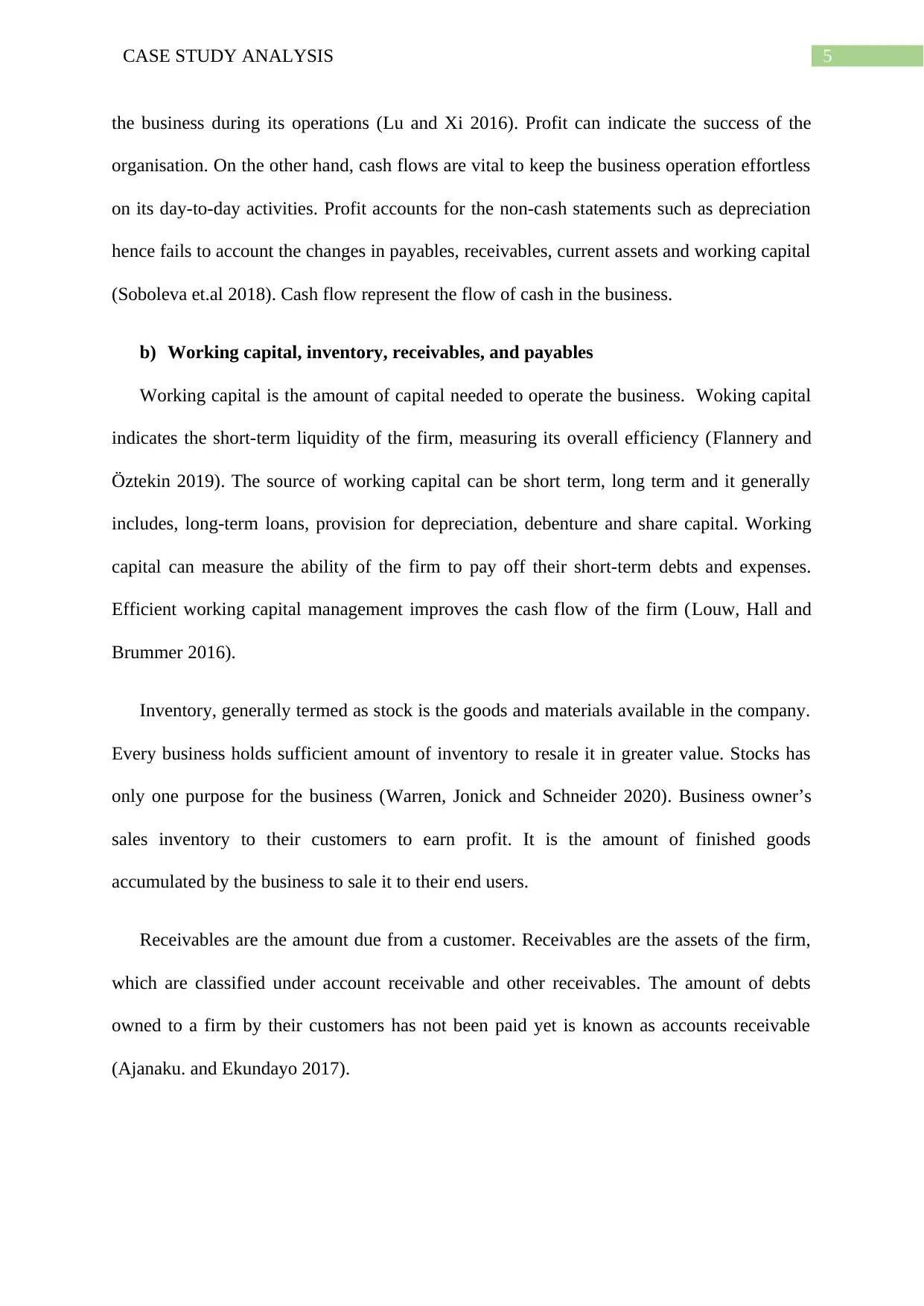
5CASE STUDY ANALYSIS
the business during its operations (Lu and Xi 2016). Profit can indicate the success of the
organisation. On the other hand, cash flows are vital to keep the business operation effortless
on its day-to-day activities. Profit accounts for the non-cash statements such as depreciation
hence fails to account the changes in payables, receivables, current assets and working capital
(Soboleva et.al 2018). Cash flow represent the flow of cash in the business.
b) Working capital, inventory, receivables, and payables
Working capital is the amount of capital needed to operate the business. Woking capital
indicates the short-term liquidity of the firm, measuring its overall efficiency (Flannery and
Öztekin 2019). The source of working capital can be short term, long term and it generally
includes, long-term loans, provision for depreciation, debenture and share capital. Working
capital can measure the ability of the firm to pay off their short-term debts and expenses.
Efficient working capital management improves the cash flow of the firm (Louw, Hall and
Brummer 2016).
Inventory, generally termed as stock is the goods and materials available in the company.
Every business holds sufficient amount of inventory to resale it in greater value. Stocks has
only one purpose for the business (Warren, Jonick and Schneider 2020). Business owner’s
sales inventory to their customers to earn profit. It is the amount of finished goods
accumulated by the business to sale it to their end users.
Receivables are the amount due from a customer. Receivables are the assets of the firm,
which are classified under account receivable and other receivables. The amount of debts
owned to a firm by their customers has not been paid yet is known as accounts receivable
(Ajanaku. and Ekundayo 2017).
the business during its operations (Lu and Xi 2016). Profit can indicate the success of the
organisation. On the other hand, cash flows are vital to keep the business operation effortless
on its day-to-day activities. Profit accounts for the non-cash statements such as depreciation
hence fails to account the changes in payables, receivables, current assets and working capital
(Soboleva et.al 2018). Cash flow represent the flow of cash in the business.
b) Working capital, inventory, receivables, and payables
Working capital is the amount of capital needed to operate the business. Woking capital
indicates the short-term liquidity of the firm, measuring its overall efficiency (Flannery and
Öztekin 2019). The source of working capital can be short term, long term and it generally
includes, long-term loans, provision for depreciation, debenture and share capital. Working
capital can measure the ability of the firm to pay off their short-term debts and expenses.
Efficient working capital management improves the cash flow of the firm (Louw, Hall and
Brummer 2016).
Inventory, generally termed as stock is the goods and materials available in the company.
Every business holds sufficient amount of inventory to resale it in greater value. Stocks has
only one purpose for the business (Warren, Jonick and Schneider 2020). Business owner’s
sales inventory to their customers to earn profit. It is the amount of finished goods
accumulated by the business to sale it to their end users.
Receivables are the amount due from a customer. Receivables are the assets of the firm,
which are classified under account receivable and other receivables. The amount of debts
owned to a firm by their customers has not been paid yet is known as accounts receivable
(Ajanaku. and Ekundayo 2017).
⊘ This is a preview!⊘
Do you want full access?
Subscribe today to unlock all pages.

Trusted by 1+ million students worldwide
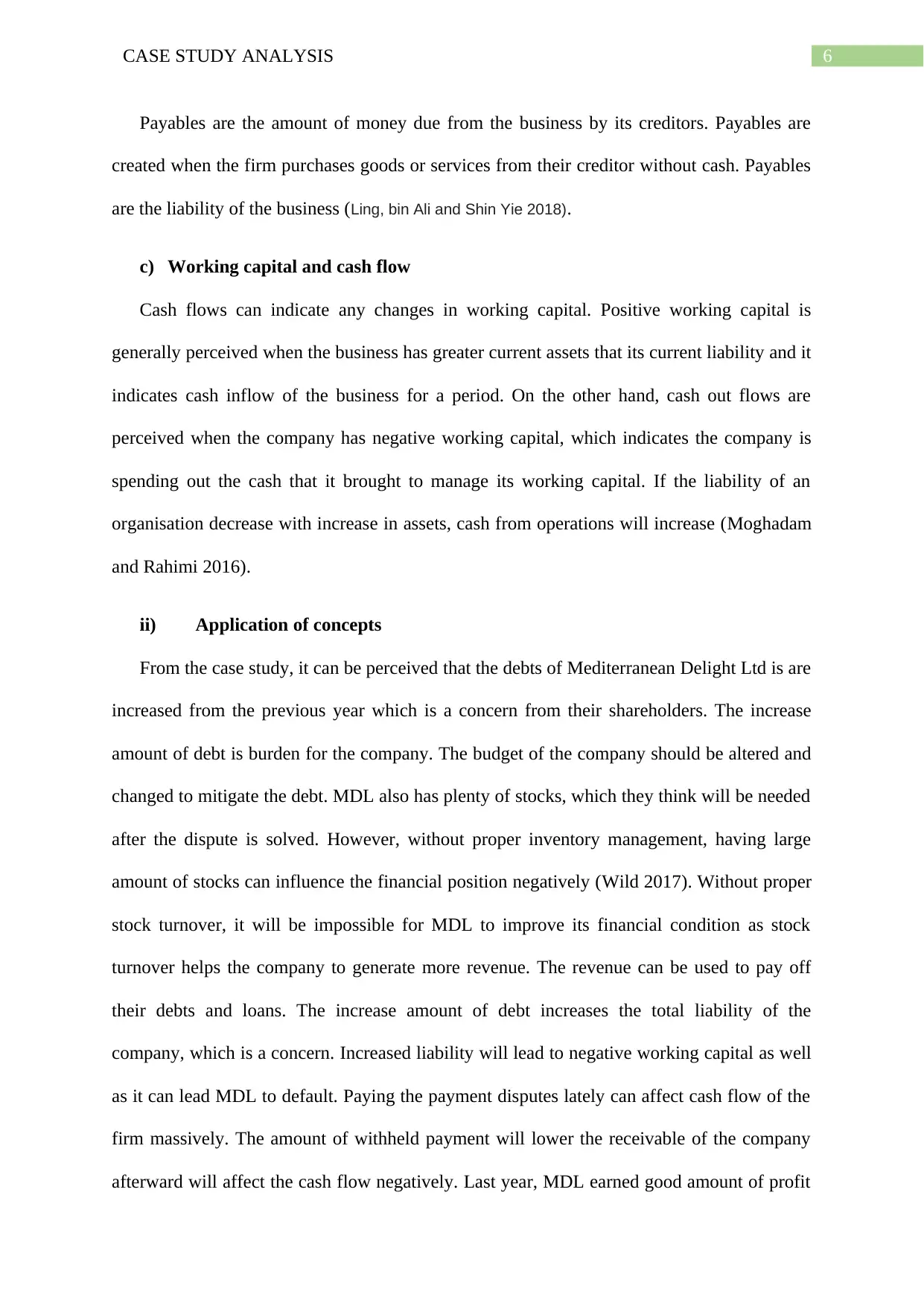
6CASE STUDY ANALYSIS
Payables are the amount of money due from the business by its creditors. Payables are
created when the firm purchases goods or services from their creditor without cash. Payables
are the liability of the business (Ling, bin Ali and Shin Yie 2018).
c) Working capital and cash flow
Cash flows can indicate any changes in working capital. Positive working capital is
generally perceived when the business has greater current assets that its current liability and it
indicates cash inflow of the business for a period. On the other hand, cash out flows are
perceived when the company has negative working capital, which indicates the company is
spending out the cash that it brought to manage its working capital. If the liability of an
organisation decrease with increase in assets, cash from operations will increase (Moghadam
and Rahimi 2016).
ii) Application of concepts
From the case study, it can be perceived that the debts of Mediterranean Delight Ltd is are
increased from the previous year which is a concern from their shareholders. The increase
amount of debt is burden for the company. The budget of the company should be altered and
changed to mitigate the debt. MDL also has plenty of stocks, which they think will be needed
after the dispute is solved. However, without proper inventory management, having large
amount of stocks can influence the financial position negatively (Wild 2017). Without proper
stock turnover, it will be impossible for MDL to improve its financial condition as stock
turnover helps the company to generate more revenue. The revenue can be used to pay off
their debts and loans. The increase amount of debt increases the total liability of the
company, which is a concern. Increased liability will lead to negative working capital as well
as it can lead MDL to default. Paying the payment disputes lately can affect cash flow of the
firm massively. The amount of withheld payment will lower the receivable of the company
afterward will affect the cash flow negatively. Last year, MDL earned good amount of profit
Payables are the amount of money due from the business by its creditors. Payables are
created when the firm purchases goods or services from their creditor without cash. Payables
are the liability of the business (Ling, bin Ali and Shin Yie 2018).
c) Working capital and cash flow
Cash flows can indicate any changes in working capital. Positive working capital is
generally perceived when the business has greater current assets that its current liability and it
indicates cash inflow of the business for a period. On the other hand, cash out flows are
perceived when the company has negative working capital, which indicates the company is
spending out the cash that it brought to manage its working capital. If the liability of an
organisation decrease with increase in assets, cash from operations will increase (Moghadam
and Rahimi 2016).
ii) Application of concepts
From the case study, it can be perceived that the debts of Mediterranean Delight Ltd is are
increased from the previous year which is a concern from their shareholders. The increase
amount of debt is burden for the company. The budget of the company should be altered and
changed to mitigate the debt. MDL also has plenty of stocks, which they think will be needed
after the dispute is solved. However, without proper inventory management, having large
amount of stocks can influence the financial position negatively (Wild 2017). Without proper
stock turnover, it will be impossible for MDL to improve its financial condition as stock
turnover helps the company to generate more revenue. The revenue can be used to pay off
their debts and loans. The increase amount of debt increases the total liability of the
company, which is a concern. Increased liability will lead to negative working capital as well
as it can lead MDL to default. Paying the payment disputes lately can affect cash flow of the
firm massively. The amount of withheld payment will lower the receivable of the company
afterward will affect the cash flow negatively. Last year, MDL earned good amount of profit
Paraphrase This Document
Need a fresh take? Get an instant paraphrase of this document with our AI Paraphraser
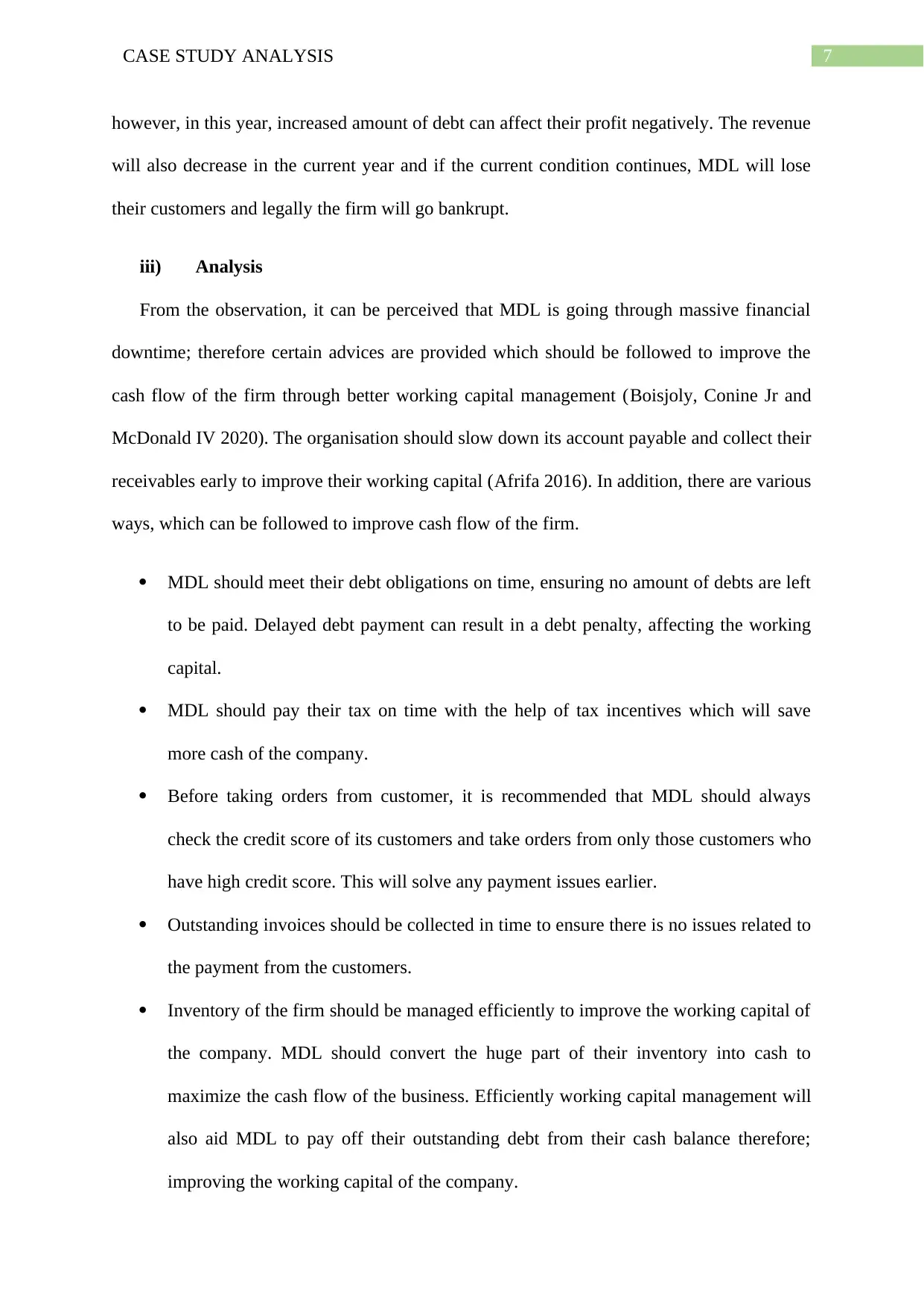
7CASE STUDY ANALYSIS
however, in this year, increased amount of debt can affect their profit negatively. The revenue
will also decrease in the current year and if the current condition continues, MDL will lose
their customers and legally the firm will go bankrupt.
iii) Analysis
From the observation, it can be perceived that MDL is going through massive financial
downtime; therefore certain advices are provided which should be followed to improve the
cash flow of the firm through better working capital management (Boisjoly, Conine Jr and
McDonald IV 2020). The organisation should slow down its account payable and collect their
receivables early to improve their working capital (Afrifa 2016). In addition, there are various
ways, which can be followed to improve cash flow of the firm.
MDL should meet their debt obligations on time, ensuring no amount of debts are left
to be paid. Delayed debt payment can result in a debt penalty, affecting the working
capital.
MDL should pay their tax on time with the help of tax incentives which will save
more cash of the company.
Before taking orders from customer, it is recommended that MDL should always
check the credit score of its customers and take orders from only those customers who
have high credit score. This will solve any payment issues earlier.
Outstanding invoices should be collected in time to ensure there is no issues related to
the payment from the customers.
Inventory of the firm should be managed efficiently to improve the working capital of
the company. MDL should convert the huge part of their inventory into cash to
maximize the cash flow of the business. Efficiently working capital management will
also aid MDL to pay off their outstanding debt from their cash balance therefore;
improving the working capital of the company.
however, in this year, increased amount of debt can affect their profit negatively. The revenue
will also decrease in the current year and if the current condition continues, MDL will lose
their customers and legally the firm will go bankrupt.
iii) Analysis
From the observation, it can be perceived that MDL is going through massive financial
downtime; therefore certain advices are provided which should be followed to improve the
cash flow of the firm through better working capital management (Boisjoly, Conine Jr and
McDonald IV 2020). The organisation should slow down its account payable and collect their
receivables early to improve their working capital (Afrifa 2016). In addition, there are various
ways, which can be followed to improve cash flow of the firm.
MDL should meet their debt obligations on time, ensuring no amount of debts are left
to be paid. Delayed debt payment can result in a debt penalty, affecting the working
capital.
MDL should pay their tax on time with the help of tax incentives which will save
more cash of the company.
Before taking orders from customer, it is recommended that MDL should always
check the credit score of its customers and take orders from only those customers who
have high credit score. This will solve any payment issues earlier.
Outstanding invoices should be collected in time to ensure there is no issues related to
the payment from the customers.
Inventory of the firm should be managed efficiently to improve the working capital of
the company. MDL should convert the huge part of their inventory into cash to
maximize the cash flow of the business. Efficiently working capital management will
also aid MDL to pay off their outstanding debt from their cash balance therefore;
improving the working capital of the company.
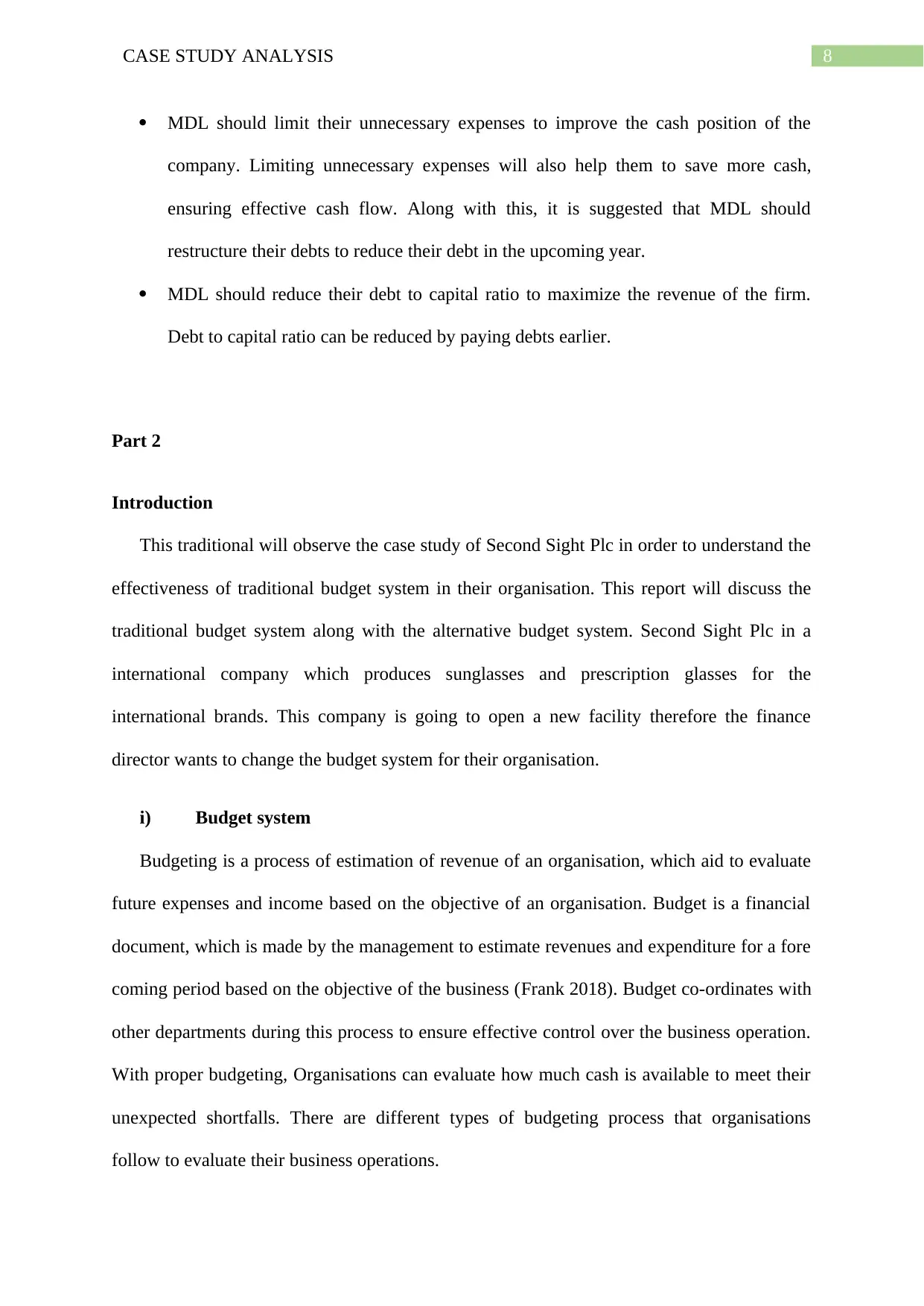
8CASE STUDY ANALYSIS
MDL should limit their unnecessary expenses to improve the cash position of the
company. Limiting unnecessary expenses will also help them to save more cash,
ensuring effective cash flow. Along with this, it is suggested that MDL should
restructure their debts to reduce their debt in the upcoming year.
MDL should reduce their debt to capital ratio to maximize the revenue of the firm.
Debt to capital ratio can be reduced by paying debts earlier.
Part 2
Introduction
This traditional will observe the case study of Second Sight Plc in order to understand the
effectiveness of traditional budget system in their organisation. This report will discuss the
traditional budget system along with the alternative budget system. Second Sight Plc in a
international company which produces sunglasses and prescription glasses for the
international brands. This company is going to open a new facility therefore the finance
director wants to change the budget system for their organisation.
i) Budget system
Budgeting is a process of estimation of revenue of an organisation, which aid to evaluate
future expenses and income based on the objective of an organisation. Budget is a financial
document, which is made by the management to estimate revenues and expenditure for a fore
coming period based on the objective of the business (Frank 2018). Budget co-ordinates with
other departments during this process to ensure effective control over the business operation.
With proper budgeting, Organisations can evaluate how much cash is available to meet their
unexpected shortfalls. There are different types of budgeting process that organisations
follow to evaluate their business operations.
MDL should limit their unnecessary expenses to improve the cash position of the
company. Limiting unnecessary expenses will also help them to save more cash,
ensuring effective cash flow. Along with this, it is suggested that MDL should
restructure their debts to reduce their debt in the upcoming year.
MDL should reduce their debt to capital ratio to maximize the revenue of the firm.
Debt to capital ratio can be reduced by paying debts earlier.
Part 2
Introduction
This traditional will observe the case study of Second Sight Plc in order to understand the
effectiveness of traditional budget system in their organisation. This report will discuss the
traditional budget system along with the alternative budget system. Second Sight Plc in a
international company which produces sunglasses and prescription glasses for the
international brands. This company is going to open a new facility therefore the finance
director wants to change the budget system for their organisation.
i) Budget system
Budgeting is a process of estimation of revenue of an organisation, which aid to evaluate
future expenses and income based on the objective of an organisation. Budget is a financial
document, which is made by the management to estimate revenues and expenditure for a fore
coming period based on the objective of the business (Frank 2018). Budget co-ordinates with
other departments during this process to ensure effective control over the business operation.
With proper budgeting, Organisations can evaluate how much cash is available to meet their
unexpected shortfalls. There are different types of budgeting process that organisations
follow to evaluate their business operations.
⊘ This is a preview!⊘
Do you want full access?
Subscribe today to unlock all pages.

Trusted by 1+ million students worldwide
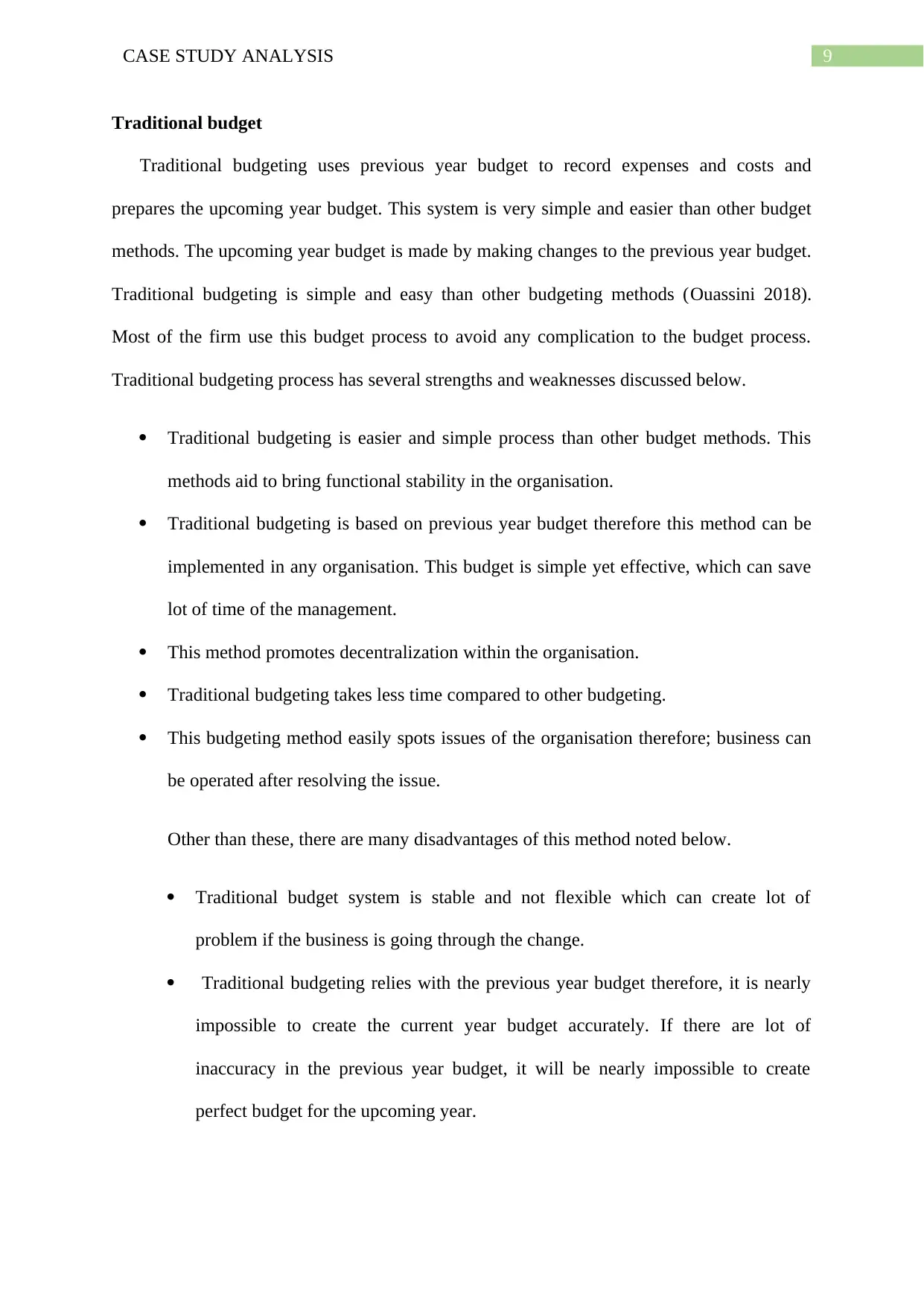
9CASE STUDY ANALYSIS
Traditional budget
Traditional budgeting uses previous year budget to record expenses and costs and
prepares the upcoming year budget. This system is very simple and easier than other budget
methods. The upcoming year budget is made by making changes to the previous year budget.
Traditional budgeting is simple and easy than other budgeting methods (Ouassini 2018).
Most of the firm use this budget process to avoid any complication to the budget process.
Traditional budgeting process has several strengths and weaknesses discussed below.
Traditional budgeting is easier and simple process than other budget methods. This
methods aid to bring functional stability in the organisation.
Traditional budgeting is based on previous year budget therefore this method can be
implemented in any organisation. This budget is simple yet effective, which can save
lot of time of the management.
This method promotes decentralization within the organisation.
Traditional budgeting takes less time compared to other budgeting.
This budgeting method easily spots issues of the organisation therefore; business can
be operated after resolving the issue.
Other than these, there are many disadvantages of this method noted below.
Traditional budget system is stable and not flexible which can create lot of
problem if the business is going through the change.
Traditional budgeting relies with the previous year budget therefore, it is nearly
impossible to create the current year budget accurately. If there are lot of
inaccuracy in the previous year budget, it will be nearly impossible to create
perfect budget for the upcoming year.
Traditional budget
Traditional budgeting uses previous year budget to record expenses and costs and
prepares the upcoming year budget. This system is very simple and easier than other budget
methods. The upcoming year budget is made by making changes to the previous year budget.
Traditional budgeting is simple and easy than other budgeting methods (Ouassini 2018).
Most of the firm use this budget process to avoid any complication to the budget process.
Traditional budgeting process has several strengths and weaknesses discussed below.
Traditional budgeting is easier and simple process than other budget methods. This
methods aid to bring functional stability in the organisation.
Traditional budgeting is based on previous year budget therefore this method can be
implemented in any organisation. This budget is simple yet effective, which can save
lot of time of the management.
This method promotes decentralization within the organisation.
Traditional budgeting takes less time compared to other budgeting.
This budgeting method easily spots issues of the organisation therefore; business can
be operated after resolving the issue.
Other than these, there are many disadvantages of this method noted below.
Traditional budget system is stable and not flexible which can create lot of
problem if the business is going through the change.
Traditional budgeting relies with the previous year budget therefore, it is nearly
impossible to create the current year budget accurately. If there are lot of
inaccuracy in the previous year budget, it will be nearly impossible to create
perfect budget for the upcoming year.
Paraphrase This Document
Need a fresh take? Get an instant paraphrase of this document with our AI Paraphraser
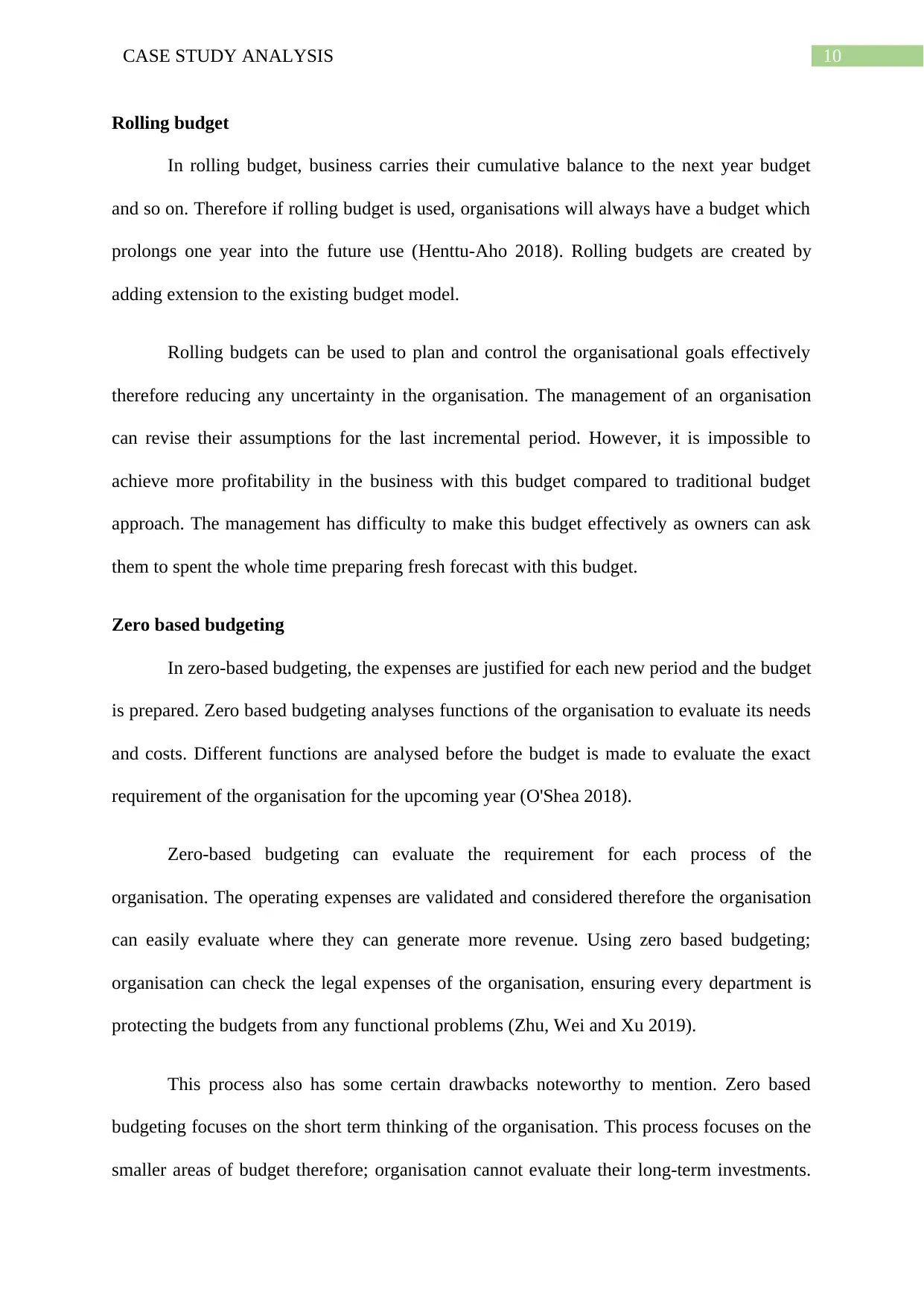
10CASE STUDY ANALYSIS
Rolling budget
In rolling budget, business carries their cumulative balance to the next year budget
and so on. Therefore if rolling budget is used, organisations will always have a budget which
prolongs one year into the future use (Henttu-Aho 2018). Rolling budgets are created by
adding extension to the existing budget model.
Rolling budgets can be used to plan and control the organisational goals effectively
therefore reducing any uncertainty in the organisation. The management of an organisation
can revise their assumptions for the last incremental period. However, it is impossible to
achieve more profitability in the business with this budget compared to traditional budget
approach. The management has difficulty to make this budget effectively as owners can ask
them to spent the whole time preparing fresh forecast with this budget.
Zero based budgeting
In zero-based budgeting, the expenses are justified for each new period and the budget
is prepared. Zero based budgeting analyses functions of the organisation to evaluate its needs
and costs. Different functions are analysed before the budget is made to evaluate the exact
requirement of the organisation for the upcoming year (O'Shea 2018).
Zero-based budgeting can evaluate the requirement for each process of the
organisation. The operating expenses are validated and considered therefore the organisation
can easily evaluate where they can generate more revenue. Using zero based budgeting;
organisation can check the legal expenses of the organisation, ensuring every department is
protecting the budgets from any functional problems (Zhu, Wei and Xu 2019).
This process also has some certain drawbacks noteworthy to mention. Zero based
budgeting focuses on the short term thinking of the organisation. This process focuses on the
smaller areas of budget therefore; organisation cannot evaluate their long-term investments.
Rolling budget
In rolling budget, business carries their cumulative balance to the next year budget
and so on. Therefore if rolling budget is used, organisations will always have a budget which
prolongs one year into the future use (Henttu-Aho 2018). Rolling budgets are created by
adding extension to the existing budget model.
Rolling budgets can be used to plan and control the organisational goals effectively
therefore reducing any uncertainty in the organisation. The management of an organisation
can revise their assumptions for the last incremental period. However, it is impossible to
achieve more profitability in the business with this budget compared to traditional budget
approach. The management has difficulty to make this budget effectively as owners can ask
them to spent the whole time preparing fresh forecast with this budget.
Zero based budgeting
In zero-based budgeting, the expenses are justified for each new period and the budget
is prepared. Zero based budgeting analyses functions of the organisation to evaluate its needs
and costs. Different functions are analysed before the budget is made to evaluate the exact
requirement of the organisation for the upcoming year (O'Shea 2018).
Zero-based budgeting can evaluate the requirement for each process of the
organisation. The operating expenses are validated and considered therefore the organisation
can easily evaluate where they can generate more revenue. Using zero based budgeting;
organisation can check the legal expenses of the organisation, ensuring every department is
protecting the budgets from any functional problems (Zhu, Wei and Xu 2019).
This process also has some certain drawbacks noteworthy to mention. Zero based
budgeting focuses on the short term thinking of the organisation. This process focuses on the
smaller areas of budget therefore; organisation cannot evaluate their long-term investments.
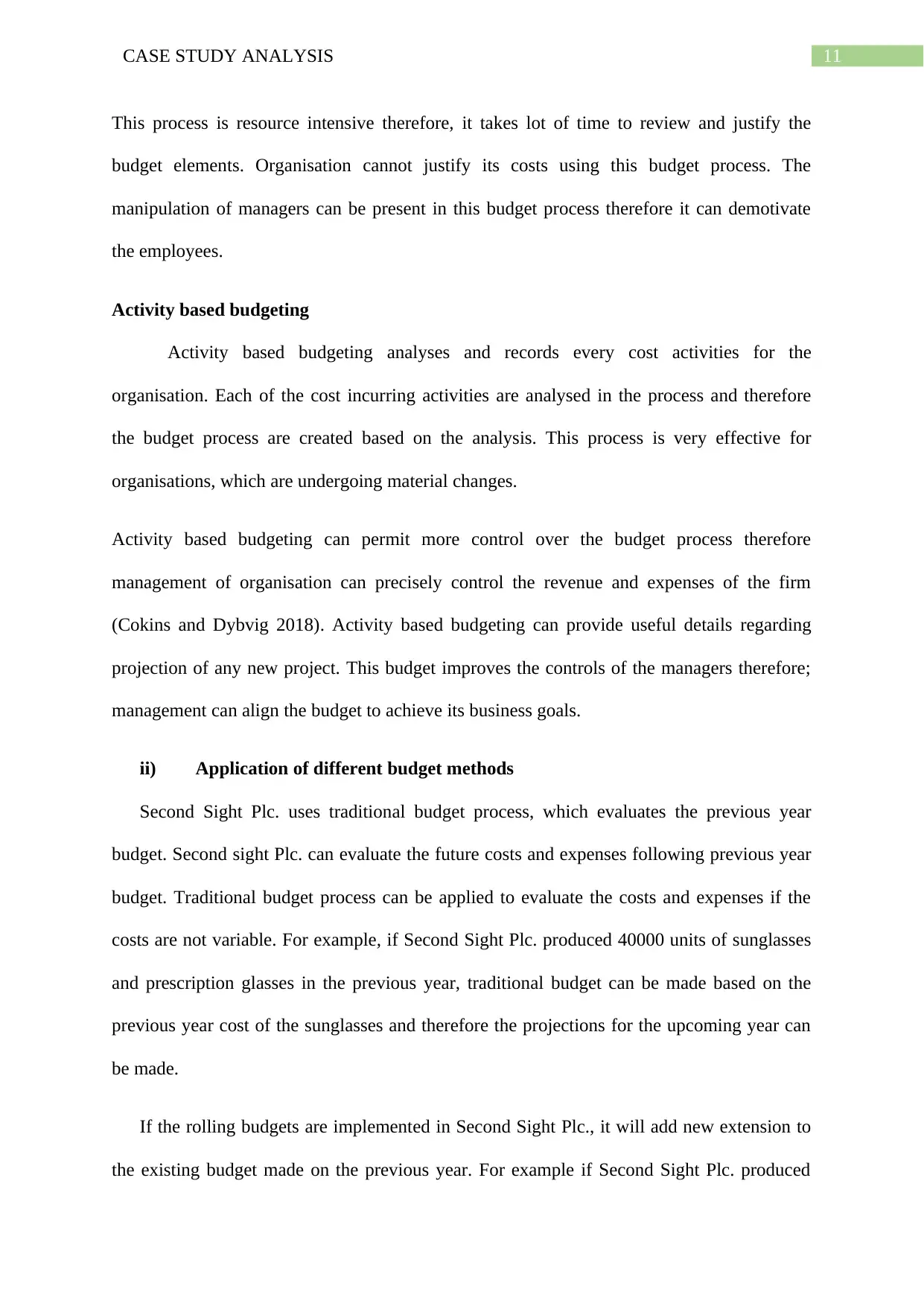
11CASE STUDY ANALYSIS
This process is resource intensive therefore, it takes lot of time to review and justify the
budget elements. Organisation cannot justify its costs using this budget process. The
manipulation of managers can be present in this budget process therefore it can demotivate
the employees.
Activity based budgeting
Activity based budgeting analyses and records every cost activities for the
organisation. Each of the cost incurring activities are analysed in the process and therefore
the budget process are created based on the analysis. This process is very effective for
organisations, which are undergoing material changes.
Activity based budgeting can permit more control over the budget process therefore
management of organisation can precisely control the revenue and expenses of the firm
(Cokins and Dybvig 2018). Activity based budgeting can provide useful details regarding
projection of any new project. This budget improves the controls of the managers therefore;
management can align the budget to achieve its business goals.
ii) Application of different budget methods
Second Sight Plc. uses traditional budget process, which evaluates the previous year
budget. Second sight Plc. can evaluate the future costs and expenses following previous year
budget. Traditional budget process can be applied to evaluate the costs and expenses if the
costs are not variable. For example, if Second Sight Plc. produced 40000 units of sunglasses
and prescription glasses in the previous year, traditional budget can be made based on the
previous year cost of the sunglasses and therefore the projections for the upcoming year can
be made.
If the rolling budgets are implemented in Second Sight Plc., it will add new extension to
the existing budget made on the previous year. For example if Second Sight Plc. produced
This process is resource intensive therefore, it takes lot of time to review and justify the
budget elements. Organisation cannot justify its costs using this budget process. The
manipulation of managers can be present in this budget process therefore it can demotivate
the employees.
Activity based budgeting
Activity based budgeting analyses and records every cost activities for the
organisation. Each of the cost incurring activities are analysed in the process and therefore
the budget process are created based on the analysis. This process is very effective for
organisations, which are undergoing material changes.
Activity based budgeting can permit more control over the budget process therefore
management of organisation can precisely control the revenue and expenses of the firm
(Cokins and Dybvig 2018). Activity based budgeting can provide useful details regarding
projection of any new project. This budget improves the controls of the managers therefore;
management can align the budget to achieve its business goals.
ii) Application of different budget methods
Second Sight Plc. uses traditional budget process, which evaluates the previous year
budget. Second sight Plc. can evaluate the future costs and expenses following previous year
budget. Traditional budget process can be applied to evaluate the costs and expenses if the
costs are not variable. For example, if Second Sight Plc. produced 40000 units of sunglasses
and prescription glasses in the previous year, traditional budget can be made based on the
previous year cost of the sunglasses and therefore the projections for the upcoming year can
be made.
If the rolling budgets are implemented in Second Sight Plc., it will add new extension to
the existing budget made on the previous year. For example if Second Sight Plc. produced
⊘ This is a preview!⊘
Do you want full access?
Subscribe today to unlock all pages.

Trusted by 1+ million students worldwide
1 out of 17
Related Documents
Your All-in-One AI-Powered Toolkit for Academic Success.
+13062052269
info@desklib.com
Available 24*7 on WhatsApp / Email
![[object Object]](/_next/static/media/star-bottom.7253800d.svg)
Unlock your academic potential
Copyright © 2020–2025 A2Z Services. All Rights Reserved. Developed and managed by ZUCOL.





